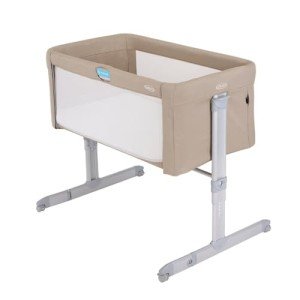The Ultimate Guide to Choosing a Bedside Bassinet: Safety, Comfort, and Convenience
Introduction
As new parents enter the thrilling yet challenging world of child care, one important product that often tops the list is a bedside bassinet. These spaces function as a safe sleeping area for newborns while enabling parents to keep close proximity during the night. With a myriad of alternatives offered on the market today, understanding the functions, advantages, and factors to consider for a bedside bassinet can make a substantial difference in the overall parenting experience.
This article will explore the different types of bedside bassinets, security standards, crucial features to consider, and some frequently asked concerns to help you make a notified decision.
What is a Bedside Bassinet?
A bedside bassinet is a sleeping space created for newborns and infants, generally used for the very first couple of months of a baby's life. It is typically smaller sized than a crib and uses the benefit of being positioned next to an adult bed, making it possible for parents to tend to their babies quickly during nighttime.
Types of Bedside Bassinets
There are a number of kinds of bedside bassinets available, each created with unique functions and benefits:
- Co-Sleeping Bassinets: These are designed to attach securely to the side of the moms and dad's bed, enabling for easy access during nighttime feedings and reassuring without completely co-sleeping.
- Standalone Bassinets: These are free-standing versions that sit beside your bed however do not connect. While they take up more space, they can in some cases offer a larger sleeping area.
- Travel Bassinets: Lightweight and portable, these bassinets are designed for households on the go. They can be folded or taken apart easily, providing benefit while taking a trip.
- Convertible Bassinets: Some designs can change into cribs or playards, extending their life expectancy and making them a more affordable option.
Advantages of Using a Bedside Bassinet
Choosing a bedside bassinet can confer various benefits, including:
- Convenience: Parents can quickly access their baby during the night for feeding, comforting, or diaper modifications without getting out of bed.
- Safety: Bassinets are designed specifically for infants, typically sticking to safety guidelines that assist reduce the threat of Sudden Infant Death Syndrome (SIDS).
- Comfort: Babies can feel protected with their parents close by, promoting a sense of safety that is conducive to better sleep.
- Space-saving: Bedside bassinets are generally compact and easy to fit in smaller bedrooms.
Secret Safety Features to Consider
When selecting a bedside bassinet, making sure security is critical. Here are a few necessary safety functions to think about:
- Stable Base: Ensure the bassinet has a strong structure that can not tip over quickly. Inspect that wheels lock into place to prevent motion.
- Breathable Fabrics: Look for products that allow air blood circulation to lower the threat of suffocation.
- Height Adjustability: A bassinette that changes to the height of your bed can enhance safety and benefit.
- No Drop Sides: Select designs that do not have drop sides, as they can posture a danger of the baby falling out or getting caught.
- Accreditation: Always ensure that the bassinet abides by safety standards set by recognized agencies like the American Academy of Pediatrics (AAP).
Extra Features to Look For
Aside from security, here are some extra functions to consider when searching for the ideal bedside bassinet:
- Storage Space: Some bassinets include built-in storage for fundamentals like diapers, wipes, and outfits.
- Rocking or Gliding Mechanism: This can help relieve babies who have problem settling to sleep.
- Sound and Light Features: Some models consist of calming noises, nightlights, or forecasts that can help soothe infants to sleep.
- Washable Components: Make sure removable covers and sheets are maker washable for easy cleaning.
Selecting the best bedside bassinet is an essential choice that can exceptionally influence the early parenting experience. By comprehending the various types offered, their benefits, vital security features, and additional benefits, parents can make an informed option to make sure both their baby's comfort and security.
Ultimately, the right bedside bassinet must accommodate individual household requires while enhancing the bond between parents and their newborns during those precious first few months.
FAQs about Bedside Bassinets
1. How long can I use a bedside bassinet for my baby?
Many bassinets are created for infants as much as about 4 to 6 months, or until the baby can roll over, bring up, or surpass the weight limit defined by the manufacturer (typically around 20-30 pounds).
2. Are bedside bassinets safe for co-sleeping?
While bedside bassinets use close proximity, it's important to guarantee they're firmly connected to the bed. Constantly follow Bedside Cot Bed For Infants for safe sleeping to decrease the threat of SIDS.
3. Can I use a bedside bassinet for an early baby?
Yes, lots of bedside bassinets can accommodate premature infants. Nevertheless, it's vital to seek advice from a pediatrician for recommendations based upon your baby's particular needs.
4. What should I try to find in regards to mattress security in a bedside bassinet?
Ensure that the bed mattress fits tightly versus the sides of the bassinet with no gaps. The bed mattress must be firm and covered with a fitted sheet to lower the danger of suffocation.
5. Exist any particular cleaning instructions I should follow?
A lot of bassinets have detachable covers that can be washed. Constantly follow the manufacturer's instructions for cleaning and keeping the bassinet.
By dealing with these questions, parents can browse the decision-making procedure concerning bedside bassinets more effectively, guaranteeing security and convenience as they invite their little one into the world.

